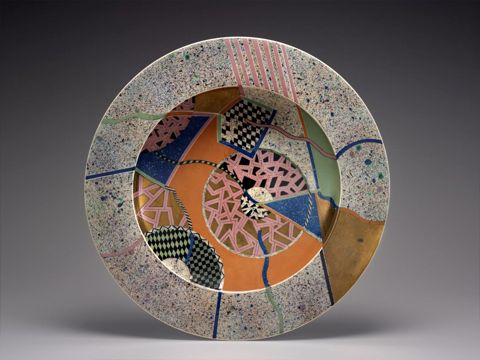Three Decades of West Coast Ceramics, 1956–1986

Ralph Bacerra, Platter, 1984, earthenware, the MFAH, Garth Clark and Mark Del Vecchio Collection, gift of Garth Clark and Mark Del Vecchio. © Estate of Ralph Bacerra
Robert H. Hudson, Jar, 1972, porcelain, the MFAH, Garth Clark and Mark Del Vecchio Collection, gift of Joan and Marvin Kaplan. © Robert Hudson
Howard Kottler, Pastoral Wood, c. 1972, the MFAH, Garth Clark and Mark Del Vecchio Collection, museum purchase with funds provided by the Caroline Wiess Law Accessions Endowment Fund. © Howard Kottler
Lucian Octavius Pompilli, Mare Te Ave, 1973, porcelain, sand, glass, and wood, the MFAH, gift of Caren Forbes, courtesy of Helen Drutt, Philadelphia. © Lucian Pompilli
Adrian Saxe, Untitled Covered Jar on Stand with Antelope Finial (Sacred Heart), 1984, porcelain, raku, and stoneware, the MFAH, Garth Clark and Mark Del Vecchio Collection, gift of Garth Clark and Mark Del Vecchio. © Adrian Saxe
Peter Voulkos, Platter, 1973, stoneware, the MFAH, the Leatrice S. and Melvin B. Eagle Collection, museum purchase with funds provided by the Caroline Wiess Law Accessions Endowment Fund. © Voulkos Family Trust
On View
February 23–June 30, 2013
Overview
The years between 1956 and 1986 witnessed a fundamental shift in American ceramics, one that took place mainly on the West Coast in California and Washington. Freed from the constraints of making functional objects, ceramics artists began experimenting with abstract and figural forms, radical building techniques and surface treatments. The resulting sculptural pieces were groundbreaking, and the search for a new aesthetic changed international ceramic art.
Key figures in this revolution were Peter Voulkos and Robert Arneson. Voulkos founded the ceramics program at the Los Angeles County Art Institute (now Otis Art Institute) in 1954 and established California as the center for avant-garde ceramic art in the mid-20th century. Arneson, an admirer of Voulkos and a teacher at the University of California, Davis, was associated with the Funk art movement which is characterized by deliberately unpolished style, over-scaled imagery and rejection of formal sculpture. While coming from different perspectives, both artists established similar atmospheres of innovation at the programs they led in California. Their respective ethos spurred ceramics artists across the state and beyond to embrace this new philosophy, leading to a 30-year period of intense creativity that produced remarkable works of sculpture.
Three Decades of West Coast Ceramics, 1956–1986 showcases works from the rich MFAH collection of American ceramics made during this important period. Specifically, the exhibition focuses on teachers and students from seminal ceramics programs at four universities:
The Los Angeles County Art Institute (now Otis Art Institute), Los Angeles
At the Los Angeles County Art Institute, Peter Voulkos created an open, experimental atmosphere that encouraged radical form and innovative glazing. Voulkos’s first students and colleagues included John Mason, Ken Price, Michael Frimkess and Paul Soldner, whose work can be seen in the exhibition.
University of California, Davis
In 1962 Robert Arneson, an admirer of Peter Voulkos, began teaching ceramics at the University of California, Davis. During his 30-year reign there, Arneson, his colleagues and his students, including Clayton Bailey, David Gilhooly, Richard Notkin, Lucian Pompili and Richard Shaw, created one of the most internationally recognized, revolutionary ceramics programs in the United States. Its legacy stems from its focus on figurative ceramics and the atmosphere of innovation and experimentation that Arneson fostered.
Chouinard Art Institute, Los Angeles
The Chouinard Art Institute was known for its progressive environment, and in the ceramics department this included having students of all levels share one large studio. The program also emphasized the vessel, and under Ralph Bacerra glazing became a specialty of many of the students. Artists such as Elsa Rady, Adrian Saxe and Mineo Mizuno are some of the Chouinard alumni featured in the exhibition.
The University of Washington, Seattle
The ceramics program at the University of Washington, Seattle, gained momentum as a leader in progressive clay art under the directorship of Robert Sperry, who began his teaching career there in 1954. The arrival in 1964 of Howard Kottler further stimulated the program’s new emphasis on sculptural and expressive concerns. Kottler’s connections to the Funk movement and his mentoring of artists such as Nancy Carman and Michael Lucero, seen in the exhibition, encouraged a turn toward using realism and Pop Art imagery in ceramics as well as experimentation with slip-cast and glazed and painted forms.
Organization
This exhibition is organized by the Museum of Fine Arts, Houston. The curator is Cindi Strauss, MFAH curator of Modern & Contemporary Decorative Arts and Design.
Generous funding is provided by Sara and Bill Morgan.
Location
Alice Pratt Brown Gallery
Caroline Wiess Law Building
The Museum of Fine Arts, Houston
1001 Bissonnet, Houston, TX 77005
Media Contact
Mary Haus, Amy Lowman, MFAH Communications, 713.639.7554
